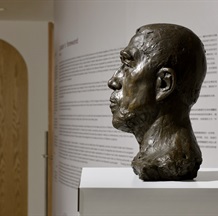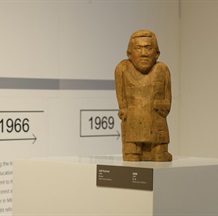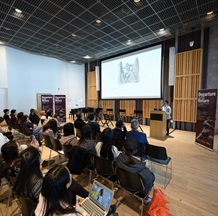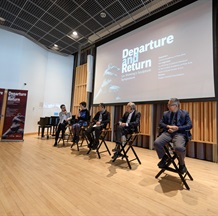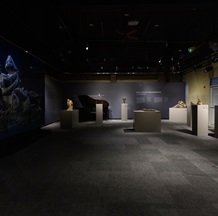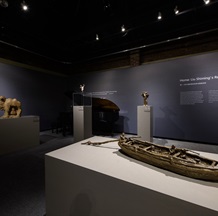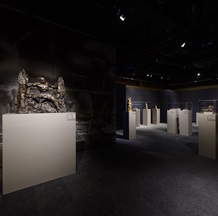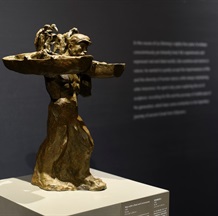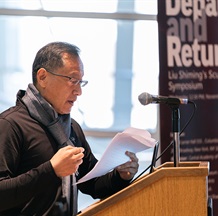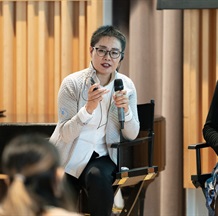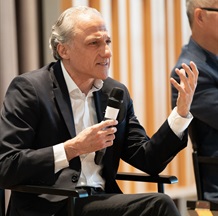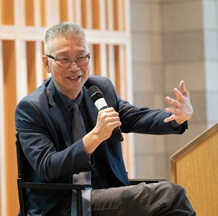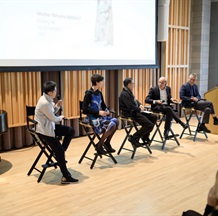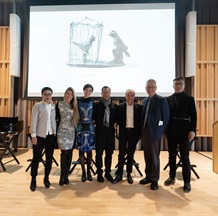In the 21st century, every country is immersed in the context of globalization. Currently, cultural exchanges and art forms are increasingly diverse. What is the significance of reexamining and discussing Liu Shiming and his sculptures in this era? Liu Shiming’s art practice spans more than a half-century and his research process actually illuminates a modern route that characterizes the Chinese feature. This modern narrative inspires artists to “look backwards” and draw nourishment from history. Thus, various creative concepts can be produced and developed based on different eras. The idea exchange and collision brought by placing this modern narrative based on our national identity in the Western context, is one of the primary directions of the project “A Liu Shiming Traveling Sculpture Exhibition” series.
On 28th October 2019, “Departure and Return: Liu Shiming’s Sculpture” commenced in the Asian Cultural Center U.S.A. (New York). In order to deepen the significance of Liu Shiming’s sculpture research and expand the discussion on the originationof his works, the related academic symposium was held at the Columbia University on 6th November, 2019.
As the first stop of “A Liu Shiming Traveling Sculpture Exhibition” series project, the exhibition in New York presented a systematic and chronological review of Liu Shiming’s artistic career. By combining the topics proposed and discussed in the symposium, the value of Liu and his works in an international context are gradually revealed. When multiple cultures and perspectives converge here, the inner strength and common spiritual ideas behind Liu’s “Chinese Method” are able to be explored in-depth; thus the second exhibition in Washington D.C. is gradually foreshadowed.
In this case, three sections are discussed in this article as a retrospective to the presentation of the exhibition “Departure and Return” in New York as well as the interpretation of the modernity behind Liu Shiming’s work.
I. Departure and Return: The Review of Liu Shiming’s Artistic Career
Liu Shiming concluded his life experience and pursuit in his self-statement. Although he experienced vicissitudes in life and drifted around the country, he has always pursued reallife. Though he left the bustling capital city for more than ten years after 1931, he engaged deeply with the poor villages and persued the most affectionate nature in the world and the genuine kindness and beauty of life in the Central Plain Region of China.
Curator Hongmei, the Associate Professor of the China Central Academy of Fine Arts, has systematically combed Liu Shiming’s artistic career. From 1946 to 1960, Liu enrolled in Beiping Fine Arts School (now the Central Academy of Fine Arts), where he was supervised by Wang Linyi and Hua Tianyou, members of the first generation of Chinese sculptors to study in France. This study period features Liu Shiming’s acceptance and accumulation of Western sculptural language. Five years of study enabled him to integrate into the French academic school and Rodin’s modern ideas about sculpture. Liu’s graduation work “Measuring Land” won the first prize in the “Red May” exhibition and later was collected by the National Museum of Czechoslovakia (now the Czech National Museum). In 1958, when he was aged 32, the sculpture “Cutting Through Mountains to Bring in Water” brought him great social prestige. Following that, he received a number of national commissions and has engaged in different public sculpture projects on glorious history, grand narrative and hero statues. At this time, Liu Shiming and the artistic figures he created not only represented the image of China in the 1950s but also gained international influence to some extent.
However, at the time when Liu Shiming experienced honors and successes, he chose to follow his inner call, moving to remote villages in China’s Central Plains and engaging with people’s daily life at the bottom of society. By doing so, Liu sought the motif of his art creation. In Liu’s perspective, although the poor people in the village live in a feudal and old-fashioned area, they present infinite vitality and live authentically. These vivid figures were deeply imprinted in Liu’s mind. He desired a language or a container to carry and express themselves.
In 1974, Liu Shiming organized a “health retirement” at the Baoding Mass Art Museum(Bao Ding Qun Zhong Yi Shu Guan) in order to move his household registration back to Beijing to reunite with his family. Once back in Beijing, he restored and replicated artifacts at the National Museum of China. This period of experience presented a significant shift in Liu Shiming’s art career. During the time working in the National Museum of China, he established and persisted in working on his artistic path, focused on the localization of sculpture. Spending seven years working with Chinese artifacts from various dynasties compelled him to concentrate on Chinese historical pottery statues. He began to return to China’s own artistic traditions and realized the emotion and connection contained in the techniques of “kneading” and “modelling” used in these works in the past clay and pottery sculptures. It was at this stage that Liu embarked on a unique path of sculpture based on the local context of China, namely “Chinese Method” entitled by himself.
Since the 1980s, Liu Shiming, who has accumulated a large number of motifs and themes and gradually clarified the artistic language, has come to the outbreak of his artistic creation. In 1980, he returned to teach in the Sculpture Department of CAFA. In CAFA’s electric kiln studio, he made more than a thousand pieces in fifteen years. Then in 1995, Liu retired from CAFA and returned to the warmth of his family, continually creating sculptures at home until 2010 when he passed away.
Overall, the artistic career of Liu Shiming is unique. He was educated in the tradition of Western sculpture, but he chose to stay away from Western techniques as he realized the limits in terms of expressing Chinese identity. Instead, he turned to look back to traditional Chinese culture and folk art for an artistic language. In this case, the “Chinese Method” not only refers to techniques developed from classic pottery statues, but also emphasizes a bond that connects the root of Chinese culture and the modern expression of current daily life.
The exhibition of Liu Shiming’s sculpture in New York extracted two crucial choices in his life as clues, namely, “departure” and “return”, to sort out artworks and related archives in different stages of Liu Shiming’s art development process. The word “departure” means leaving the glory and prosperity in the capital city and staying a clear distance away from the Western sculptural system he was educated. While “return” refers to the time when Liu was back to Beijing after more than ten-year experience of real feelings of life and an emotional connection among people. He dug into the traditional art and national spirit of China to seek an artistic language to express what he saw and experienced in rural areas, which realized a revival of traditional artistic techniques. Moreover, in his later years, he created pottery works to pin his affections to his family, which manifested in an internal return of his family life and personal emotion.
II. “You are here.” & “I am here.”: About Liu Shiming
“Savant II” is Liu Shiming’s nickname, which was given by his friends in his early years. Liu has suffered from polio since his childhood. Professor Ma Lu, Dean of Fine Arts Department at CAFA, holds the view that it was such a hell-like experience that made Liu Shiming not afraid of images representing death and hell, but rather eager to learn about Water and Landscape Paintings (Shui Lu Hua, CN.水陆画)and paper-made figures and horses for funeral. When he was a teenager, Liu Shiming liked to go to the Dongyue Temple to see mud-dyed idols. In his memory, in addition to the ghost and god statues in the temple, he was impressed by the four shocking Chinese characters “你可来了”(Ni Ke Lai Le EN. You are here), which reveals the helplessness of people confronting the hell trial after their death. However, Liu Shiming replied “I am here” (Wo Lai Le, CN.我来了) as the response to the death trail, which shows him as calm and magnanimous. He was well aware of life’s beauty and value so that he could confront the inherent fate of death valorously and frankly.
Liu Wei, the son of Liu Shiming, recalled his father in the article “Long Live Savant II”. Liu Wei mentioned that Liu Shiming contracted polio when he was a child, which later developed into progressive muscular degeneration. “All his life, he searched for ways to cure himself—he often wrote prescriptions for himself.” It seems that Liu Shiming’s destiny may have been fixed since his childhood, but he positively fought against the negative factors in his life. He sought every opportunity to heal himself and exercise himself. He also trained his eyes in the darkness so that he could capture the faint changes and minute details so as to experience various personalities of images.
Liu Shiming enjoyed staying with authentic people, and he was always impressed and remembered others’ help and kindness. His enthusiasm for life was intertwined with his experience in the China Central Plains Area. Thus, he gradually clarified the motif of his own art creation. His frank attitude towards death, the interest of hell-related images and his experience of working with cultural relics in the National Museum of China allowed him to retrospect the traditional techniques rooted in the Chinese context in the process of seeking his own artistic language. The trace of history enabled him to achieve his unique way of containing his own artistic image and expressing his emotions.
There is a “humanist spirit” behind Liu’s sculpture. It is either because of his life vicissitudes or due to his life-long consideration of life and death. Based on traditional techniques and the culture of folk art, the “humanist spirit” connects various series of his works and conveys the spiritual energy that is rooted in everyone’s deep heart.
III. The Spiritual Journey of “Savant II” in New York: The Empathy of Liu Shiming’s Sculptures
Can Liu Shiming’s pottery sculpture based on traditional folk statues be accepted within a Western perspective? Can the national modernity conveyed by Liu Shiming’s art arise resonance across cultures and languages? When Liu Shiming’s sculptures and the“Chinese Method” traveled to New York, the exhibition extended the discussion to the contemporary and cosmopolitan nature behind Liu’s works. Furthermore, the direction and possibility of Chinese contemporary art in the future can be explored as well.
Following the exhibition in Asian Cultural Center New York, the academic symposium featuring Liu Shiming’s art and art spirit commenced at the Columbia University. The symposium integrated topics of “Chinese Method” under the Western perspective, a comparison of Chinese and Western sculptural materials and techniques as well as the emotions and modernity rooted in both cultural contexts.
French visual artist Aima Saint Hunon has been exposed to ceramic and pottery art in Jingdezhen, Jiangxi Province, China. This exhibition allowed her to learn about Liu and his works for the first time. From her point of view, Liu’s sculpture can convey the unique soul of Chinese people. Using clay as the medium, Liu expressed the inner portrayal of himself as well as millions of ordinary people in China. His sculptural subjects focus on the daily life which represents the cultural identity and national character of China. As a material, clay is primary and straightforward. It comes from the earth, so the creator can apply their most direct emotion to it. Liu Shiming transferred clay into an intermedia for freedom. The humanist spirit transmitted by his works has spanned languages, cultures and fields and has been passed on to viewers around the world.
The encounter between Liu Shiming and Italian professor and sculptor Dionisio Cimarelli happened as early as 1986. He learned about Liu’s works through his friend’s introduction. At that time, Dionisio was also engaged in the practice of sculptural art and felt the resonance with Liu’s artworks. In his view, Liu Shiming did not make pottery sculptures as maquettes for future works. Instead, he regarded them as the final pieces. Liu Shiming is thinking of clay when he is making sculptures, which is essential. By doing so, viewers can perceive the expression and natural position of the figure. His works feature simplicity and fewer details, which presents Liu’s interpretation of the soul of the sculpture. As terra cotta in the ceramic showcases a part of Italian culture, Dionisio believes clay as a natural material, although simple and cheap, can convey an extremely interesting expression. Dionisio is glad to see the promotion of Liu Shiming as an artist. No matter if they are Chinese artists or Italian artists, they should look back to their history, which does not mean to repeat previous works. Instead, it requires the artists to present the identity of the man in a new and contemporary way. It is worthwhile seeing Liu’s work concentrate on the human being, on expression and the soul of human beings.
Professor Ma Lu, Dean of the Fine Arts Department at CAFA, discussed the spirit behind Liu Shiming’s sculptures. We admire Liu works in this era mainly because he has completely jumped out of the conception of the past. From the theme matter, many of his works may be duplicated with others, but the unique feeling inscribed on his sculpture makes his works unparalleled. It is not the subject of art creation but an emotion delivered through works that counts. Such a feeling can provide visual arts with the best content. In this case, Liu Shiming’s sculptures cannot only bring Western art world the intervention of traditional Chinese figurative art techniques, but can also allow viewers to cross the gulf among diverse cultures and languages to experience sincerity in art and the power of the humanist spirit.
In fact, in addition to traditional monumental sculptures, with the development of contemporary art trends and theories, the sculpture itself is developed as a container for artists’ thoughts transmission, such as Joseph Beuys’ notion of “Social Sculpture” and Matthew Barney’s constant attempt on diversified experimental sculptures etc. In such a context, the empathy between artists, artworks and viewers is particularly important, which is reflected as one of the main characters in Liu’s sculpture. It is precisely the “modernity” that his work can make discourses for itself no matter what era or field it is in.
The power of this “modernity” is that even if such a work with Chinese characteristics and reflecting Chinese cultural emotions is placed in the Western field and challenges art forms and techniques of Western art, its nationality will not be ignored and dissolved. Instead, its nature and identity attract Western spectators to actively read “Chinese stories”.
The exhibition in New York ends up with the exploration of the humanist spirit behind Liu Shiming and his works in the Western context. This issue will be further discussed in the next exhibition “Kindness Expresses Truth and Love” in Washington, D.C.. As the intersection of Chinese culture and Western culture, the humanist spirit will facilitate the cognition and the insight of Liu’s artistic spirit in the Western context.
Edited by Sue/CAFA ART INFO
Photo by Qi Siyang and Lu Weijia
Courtesy of the organizers


